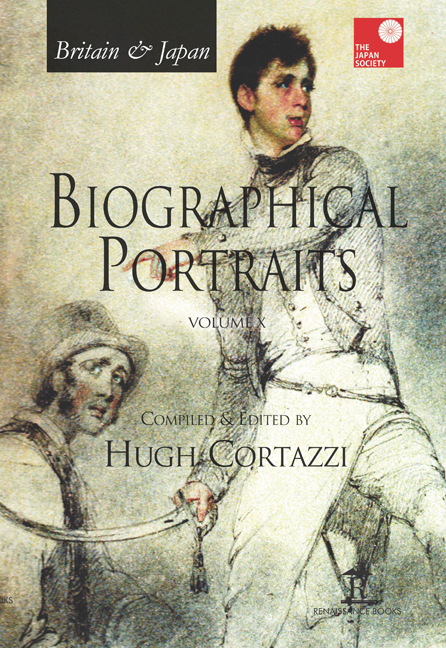Book contents
- Frontmatter
- Dedication
- Contents
- Introduction
- List of Contributors
- Index of Biographical Portraits in Japan Society Volumes
- PART I BRITAIN IN JAPAN
- PART II JAPAN IN BRITAIN
- Select Bibliography of Works in English on Anglo-Japanese Relations [Compiled by Gill Goddard – Retired East Asian Studies Librarian, University of Sheffield]
- Select Bibliography of Works in Japanese on Anglo-Japanese Relations [Compiled by Akira Hirano, SISJAC]
- Index
13 - Peter Martin (1931–2004): Successful Author and British Council Representative
Published online by Cambridge University Press: 07 May 2022
- Frontmatter
- Dedication
- Contents
- Introduction
- List of Contributors
- Index of Biographical Portraits in Japan Society Volumes
- PART I BRITAIN IN JAPAN
- PART II JAPAN IN BRITAIN
- Select Bibliography of Works in English on Anglo-Japanese Relations [Compiled by Gill Goddard – Retired East Asian Studies Librarian, University of Sheffield]
- Select Bibliography of Works in Japanese on Anglo-Japanese Relations [Compiled by Akira Hirano, SISJAC]
- Index
Summary
INTRODUCTION
‘IT IS ALWAYS in a funny sense work to be a gaijin here. Or perhaps like walking a tightrope all the time: exhilarating but exhausting.’
The bare facts of Peter Martin's ‘official’ career reveal little about his deep engagement with Japan and his impact as a writer of note. Japan affected him profoundly and he in turn contributed enormously to the interpretation and understanding of its culture and society, both through his British Council work and his books.
EARLY DAYS
Roy Peter Martin (he hated the ‘Roy’) was born in 1931, the son of a postal worker, and was educated at Highbury Grammar School and then at Birkbeck College, University of London, where he completed a bachelor's degree in philosophy with honours in 1953. His university studies were interrupted by national service in the Royal Air Force Education Branch from 1950 to 1951. Before and after military service, he worked briefly as a local government officer for the London County Council, and after graduation, as a schoolteacher. In 1954 he returned to Birkbeck, and completed a master's degree in political philosophy in 1956. He was a deputy publicity officer for the Royal Festival Hall (1956–1960) and undertook additional graduate study (1958–1959) at the University of Tübingen, where he met his Americanborn second wife, Joan Drumwright, who was later to accompany him to Japan. He had married his first wife, Marjorie Peacock, in 1951 but this relationship was dissolved in 1960, the year that he joined the British Council, which became his career base for the next twenty-three years.
KYOTO 1963–70
His first British Council job, curtailed by political instability, was in Surabaya in Indonesia, but it was his posting to Kyoto in 1963 which began a long and productive relationship with Japan. Kyoto was where all the British visitors to Japan wanted to go, or where the Embassy sent them to fill out a programme, and, as the only ‘official’ British figure there, Peter (who had taken over from Francis King, another writer) was expected to entertain politicians and other dignitaries as well as writers, artists, musicians and actors.
‘Right, Martin’, said the General briskly in his clipped senior officer’s voice, ‘They tell me that while I’m here I should see a temple, a shrine and a garden. Take me to one of each, would you, there's a good chap.’ The list of celebrities included Janet Baker – his particular favourite, whose voice was heard at his funeral, Tony Benn, Iris Murdoch, Angus Wilson, Bridget Riley, Paul McCartney and Emlyn Williams – ‘All I require from you is a bottle of gin and to be left alone!’ Peter managed to spill drinks twice on Princess Margaret at the opening of the new centre. (The quotations above are from his amusing account of various encounters in Japan Experiences: Post-war Japan through British Eyes Ed. Hugh Cortazzi, Japan Library, 2001, pp. 125–128.)
- Type
- Chapter
- Information
- Britain & Japan Biographical Portraits Vol X , pp. 155 - 168Publisher: Amsterdam University PressPrint publication year: 2016

